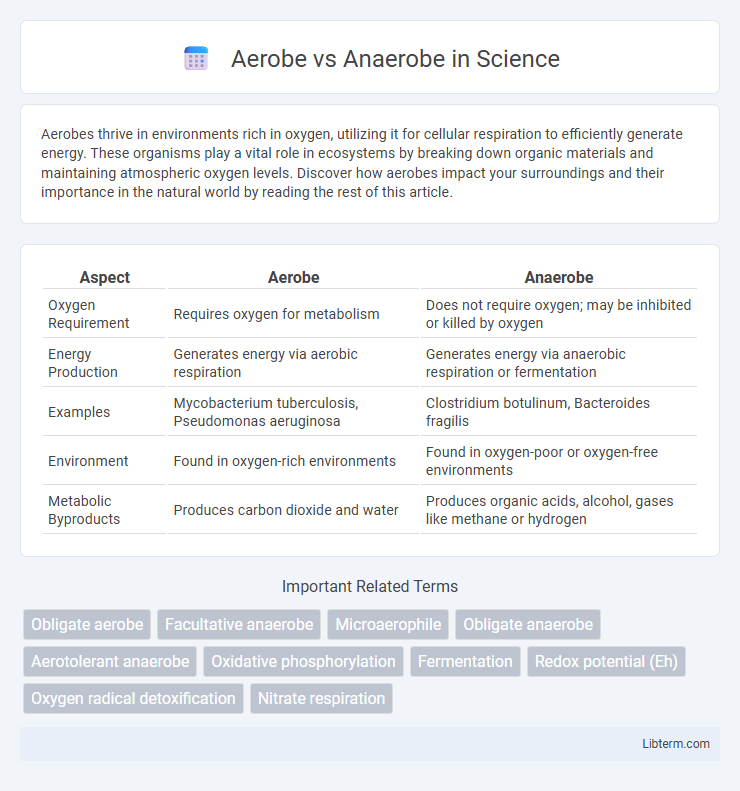Aerobes thrive in environments rich in oxygen, utilizing it for cellular respiration to efficiently generate energy. These organisms play a vital role in ecosystems by breaking down organic materials and maintaining atmospheric oxygen levels. Discover how aerobes impact your surroundings and their importance in the natural world by reading the rest of this article.
Table of Comparison
| Aspect | Aerobe | Anaerobe |
|---|---|---|
| Oxygen Requirement | Requires oxygen for metabolism | Does not require oxygen; may be inhibited or killed by oxygen |
| Energy Production | Generates energy via aerobic respiration | Generates energy via anaerobic respiration or fermentation |
| Examples | Mycobacterium tuberculosis, Pseudomonas aeruginosa | Clostridium botulinum, Bacteroides fragilis |
| Environment | Found in oxygen-rich environments | Found in oxygen-poor or oxygen-free environments |
| Metabolic Byproducts | Produces carbon dioxide and water | Produces organic acids, alcohol, gases like methane or hydrogen |
Introduction to Aerobes and Anaerobes
Aerobes are microorganisms that require oxygen for growth and energy production through cellular respiration, utilizing oxygen as the final electron acceptor in their metabolic processes. Anaerobes thrive in environments devoid of oxygen, relying on fermentation or anaerobic respiration using alternative electron acceptors for energy generation. Understanding the fundamental metabolic distinctions between aerobes and anaerobes is essential for applications in microbiology, biotechnology, and medical research.
Defining Aerobic and Anaerobic Microorganisms
Aerobic microorganisms require oxygen for growth and energy production, utilizing oxygen as the final electron acceptor in cellular respiration. Anaerobic microorganisms thrive in oxygen-free environments, relying on fermentation or anaerobic respiration using alternative electron acceptors like nitrate or sulfate. These metabolic differences define their ecological niches and influence processes such as biodegradation and pathogen survival.
Energy Production Pathways: Aerobic vs Anaerobic
Aerobes produce energy through aerobic respiration, utilizing oxygen as the final electron acceptor in the electron transport chain, which generates up to 38 ATP molecules per glucose molecule. Anaerobes rely on anaerobic respiration or fermentation pathways, using alternative electron acceptors like nitrate or sulfate, or converting glucose into lactic acid or ethanol, resulting in significantly lower ATP yields, typically 2 ATP per glucose. This difference in energy production pathways influences organismal growth rates and ecological niches.
Oxygen Requirements and Tolerance
Aerobes require oxygen for survival and energy production, utilizing it as the final electron acceptor in cellular respiration, while anaerobes do not rely on oxygen and may even find it toxic. Obligate aerobes need a continuous oxygen supply, whereas obligate anaerobes thrive only in oxygen-free environments. Facultative anaerobes can switch between aerobic respiration and anaerobic metabolism depending on oxygen availability, showing high tolerance to varying oxygen levels.
Key Differences in Metabolic Processes
Aerobes utilize oxygen as the final electron acceptor in their electron transport chain, enabling efficient ATP production through oxidative phosphorylation. Anaerobes rely on alternative electron acceptors or fermentation processes, generating energy without oxygen but yielding less ATP. This fundamental difference influences their habitat preference, metabolic pathways, and tolerance to oxygen presence.
Common Examples of Aerobes and Anaerobes
Aerobes include organisms such as Pseudomonas aeruginosa, Mycobacterium tuberculosis, and Bacillus subtilis that require oxygen for growth and metabolism. Anaerobes, such as Clostridium botulinum, Bacteroides fragilis, and Methanogens, thrive in oxygen-free environments and often participate in fermentation or anaerobic respiration. Understanding these examples helps in microbiology, infectious disease treatment, and environmental research focused on oxygen availability.
Ecological Roles and Habitats
Aerobes thrive in oxygen-rich environments such as soil surfaces, freshwater, and marine habitats, where they play a critical role in decomposing organic matter and cycling nutrients like carbon and nitrogen. Anaerobes dominate oxygen-depleted habitats such as deep sediments, wetlands, and animal gastrointestinal tracts, contributing significantly to processes like methane production, sulfate reduction, and nitrogen fixation. These contrasting ecological roles affect global biogeochemical cycles and influence ecosystem productivity and stability.
Industrial and Medical Applications
Aerobic microorganisms are widely utilized in industrial applications such as wastewater treatment and aerobic fermentation processes for producing antibiotics and enzymes, leveraging their oxygen-dependent metabolism for efficient degradation and biosynthesis. Anaerobic microbes play a crucial role in biogas production, anaerobic digestion, and fermentation industries, generating methane and solvents like ethanol without oxygen presence, which is pivotal for renewable energy and chemical manufacturing. In medical contexts, aerobic bacteria are targeted in treatments of infections like pneumonia, while anaerobes are significant in understanding conditions such as deep-tissue abscesses and are exploited for probiotic therapies and anaerobic infections management.
Health Implications: Benefits and Risks
Aerobic bacteria promote gut health by aiding digestion and producing essential vitamins, while anaerobic bacteria play a crucial role in inflammation regulation and immune system balance. However, an overgrowth of anaerobic pathogens can lead to infections and contribute to conditions like bacterial vaginosis and Clostridium difficile colitis. Maintaining a balanced microbiome with both aerobic and anaerobic microbes is vital for overall health and preventing disease.
Summary and Future Perspectives
Aerobes require oxygen for cellular respiration, producing energy efficiently through oxidative phosphorylation, while anaerobes thrive in oxygen-free environments using fermentation or anaerobic respiration. Advances in microbial biotechnology aim to exploit both aerobic and anaerobic pathways for sustainable energy production, waste treatment, and bioremediation. Future research focuses on engineering metabolic pathways to enhance microbial efficiency and resilience under variable oxygen conditions, expanding applications in environmental and industrial biotechnology.
Aerobe Infographic

 libterm.com
libterm.com